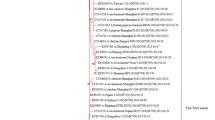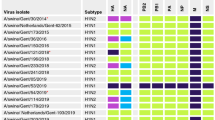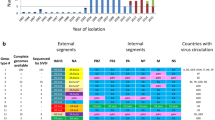Abstract
The epidemic situation of A H1N1 flu arose in North America in April 2009, which rapidly expanded to three continents of Europe, Asia and Africa, with the risk ranking up to 5. Until May 13th, the flu virus of A H1N1 had spread into 33 countries and regions, with a laboratory confirmed case number of 5728, including 61 deaths. Based on IRV and EpiFluDB database, 425 parts of A H1N1 flu virus sequence were achieved, followed by sequenced comparison and evolution analysis. The results showed that the current predominant A H1N1 flu virus was a kind of triple reassortment A flu virus: (i) HA, NA, MP, NP and NS originated from swine influenza virus; PB2 and PA originated from bird influenza virus; PB1 originated from human influenza virus. (ii) The origin of swine influenza virus could be subdivided as follows: HA, NP and NS originated from classic swine influenza virus of H1N1 subtype; NA and MP originated from bird origin swine influenza virus of H1N1 subtype. (iii) A H1N1 flu virus experienced no significant mutation during the epidemic spread, accompanied with no reassortment of the virus genome. In the paper, the region of the representative strains for sequence analysis (A/California/04/2009 (H1N1) and A/Mexico/4486/2009 (H1N1)) included USA and Mexico and was relatively wide, which suggested that the analysis results were convincing.
Similar content being viewed by others
References
Brown I H. The epidemiology and evolution of influenza viruses in pigs. Vet Microbiol, 2000, 74: 29–46
Olsen C W, Brown I H, Easterday B C, et al. Swine influenza. In: Straw B E, Zimmerman J J, D’Allaire S, eds. Diseases of Swine. 9th ed. Aimes, Iowa: Blackwell Publishing Professional, 2006. 469–482
Taubenberger J K, Reid A H, Janczewski T A, et al. Integrating historical, clinical and molecular genetic data in order to explain the origin and virulence of the 1918 Spanish influenza virus. Philos Trans R Soc Lond B Biol Sci, 2001, 356: 1829–1839
Olsen C W. The emergence of novel swine influenza viruses in North America. Virus Res, 2002, 85: 199–210
Pensaert M, Ottis K, Vandeputte J, et al. Evidence for the natural transmission of influenza A virus from wild ducts to swine and its potential importance for man. Bull World Health Organ, 1981, 59: 75–78
Scholtissek C, Burger H, Bachmann P A, et al. Genetic relatedness of hemagglutinins of the H1 subtype of influenza A viruses isolated from swine and birds. Virology, 1983, 129: 521–523
Karasin A I, Schutten M M, Cooper L A, et al. Genetic characterization of H3N2 influenza viruses isolated from pigs in North America, 1977-1999: evidence for wholly human and reassortant virus genotypes. Virus Res, 2000, 68: 71–75
Webby R J, Swenson S L, Krauss S L, et al. Evolution of swine H3N2 influenza viruses in the United States. J Virol, 2000, 74: 8243–8251
Zhou N N, Senne D A, Landgraf J S, et al. Genetic reassortment of avian, swine, and human influenza A viruses in American pigs. J Virol, 1999, 73: 8851–8856
Bao Y, Bolotov P, Dernovoy D, et al. The Influenza Virus Resource at the National Center for Biotechnology Information. J Virol, 2008, 82: 596–601
Dunham E J, Dugan V G, Kaser E K, et al. Different evolutionary trajectories of European avianlike and classical swine H1N1 influenza A viruses. J Virol, 2009, doi:10.1128/JVI.02565-08. Available: http://jvi.asm.org/cgi/content/short/JVI.02565-08v1.
Novel Swine-Origin Influenza A (H1N1) Virus Investigation Team. Emergence of a novel swine-origin influenza a (H1N1) virus in humans. N Engl J Med, 2009, doi: 10.1056/ nejmoa0903810. Available: http://content.nejm.org/cgi/content/full/NEJMoa0903810.
Author information
Authors and Affiliations
Corresponding author
Additional information
Supported by the National Key Basic Research and Development of China (Grant Nos. 2007FY210700, 2005CB523007), the Knowledge Innovation Project of the Chinese Academy of Sciences (Grant No. KSCX2-YW-N-065), the e-Science Project of the Chinese Academy of Sciences (Grant No. IN-FO-115-D02) and the Sixth Framework Program in European (Grant Nos. SP5B-CT-2006-044161, SP5B-CT-2006-044405).
About this article
Cite this article
Kou, Z., Hu, S. & Li, T. Genome evolution of novel influenza A (H1N1) viruses in humans. Chin. Sci. Bull. 54, 2159–2163 (2009). https://doi.org/10.1007/s11434-009-0412-z
Received:
Accepted:
Published:
Issue Date:
DOI: https://doi.org/10.1007/s11434-009-0412-z




